How to arrange the heating of a private house with your own hands: schemes for organizing an autonomous heating system
Owners of private houses know for sure that an autonomous heating system is much more economical and more efficient than a centralized one. Many homeowners trust the solution of the question of housing heating to specialists who carry out calculations, design and supervise the arrangement of heat supply.
However, there are also such masters who decide to equip the heating of a private house with their own hands, so as not to overpay for the services of specialists. But this is not a small savings from the family budget, agree?
Before proceeding to the calculations and design, it is necessary to determine the optimal version of the system and its components. We will help you in resolving these issues.
The article provides a detailed overview of possible engineering solutions for a private house, outlines the pros and cons of each scheme, the principles of their work and the nuances of installation.
The content of the article:
Heating system: what they are
There are many engineering solutions for heating a home. There are three main types of heating systems.
Heating system with liquid coolant
The most common way in our country to heat your home. Assumes the presence of a closed loop in which circulates heat transfer fluid.
As the latter, water is most often used, but there can be various antifreezes, which are favorably distinguished by a low freezing temperature. To heat the coolant, a boiler of any suitable type is installed in the system.
The heated coolant is piped into the rooms where it enters the radiators. These devices are designed to transfer heat to the air. In the batteries, the coolant cools down, after which it goes through the pipes to the boiler, where it again heats up.
Such a cycle is repeated many times. Thermostats can be used to regulate the system, which allows you to automatically maintain the set temperature, or taps. In this case, manual regulation is performed.
Heating using a coolant is a fairly simple system to design and execute. If necessary, you can assemble it yourself. But at the same time, it is certainly advisable to show the project to specialists in order to avoid errors that can significantly reduce the effectiveness of the system.
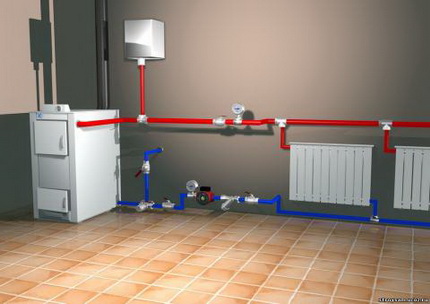
Among the advantages include the long life of the structure, provided that a competent installation has been made and there are no violations in operation.
The system works silently, extremely easy to repair and maintain. It is important that with a correctly executed project in all heated rooms it is possible to maintain the desired temperature.
The system is efficient and saves energy. The energy intensity of the coolant is about 4000 times higher than that of air. This allows you to relatively quickly heat indoor air to a comfortable temperature.
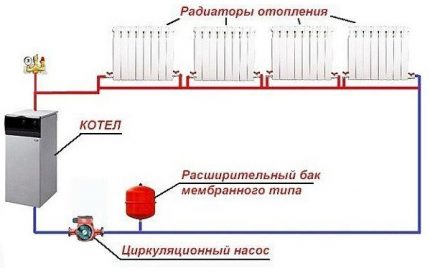
Of the shortcomings, it is worth noting that such heating can be installed only during the construction or major repairs of the house. If water is used as a heat carrier, it must be taken into account that its freezing temperature is quite high. What can threaten damage to pipes when the system freezes.
In addition, the presence of air in pipes with water provokes rapid corrosion of structural elements.
Air heating
The coolant in this case is heated air. It is heated by a water or steam heater installed in the building, as well as an electric or hot air heater. After the heat treatment, the prepared gaseous medium enters the room.
According to the principle of operation, air heating schemes are divided into two types:
- combined with ventilation;
- recirculating.
The first option involves a partial mixture of a fresh portion of air captured from the street, and an equal volume of exhaust gas-air mass emission.
In the second embodiment, the entire air flow circulating around the room is captured and sent to the air heater for processing. Then it comes back in full. It is clear that for sanitary indicators, the first scheme is in preference.
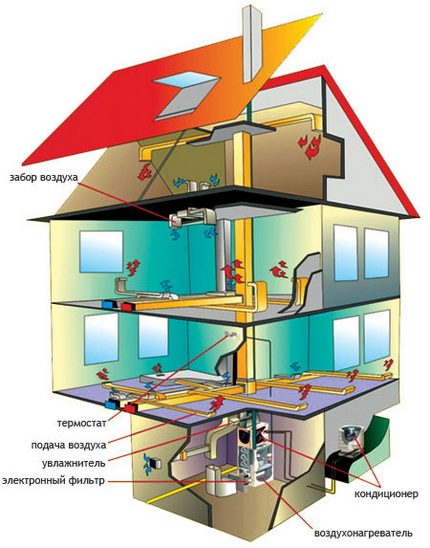
Heated to 55-60 ° C, the air enters the ducts, through which it is discharged into the rooms. Here it is distributed as evenly as possible. After cooling, the air masses are lowered, where they pass through the openings closed by the grill into the return duct, through which they return to the heater. The cycle is repeated many times.
Such a heating system is regulated only by means of automation, which makes the temperature in the rooms extremely comfortable.
Air heating is as safe as possible, since automation monitors all system parameters and, when problems arise, blocks its elements. In addition, the design does not contain pipes filled with hot liquid, which, under adverse circumstances, can burst or leak.
In air heating circuits there are no radiators familiar to the average person, which, coupled with the lack of pipes, significantly affects the cost of building the system. There are no steam valves and water heating types of shutoff valves.
With the device of the circuit combined with ventilation, the issue of updating the composition of the air mass is also reasonably solved.
The term of operation, subject to competent air heating installationis about 20 years. The advantages include the external appeal of air heating. Plexes of pipes, necessary for structures with a liquid coolant, are absent in this case.
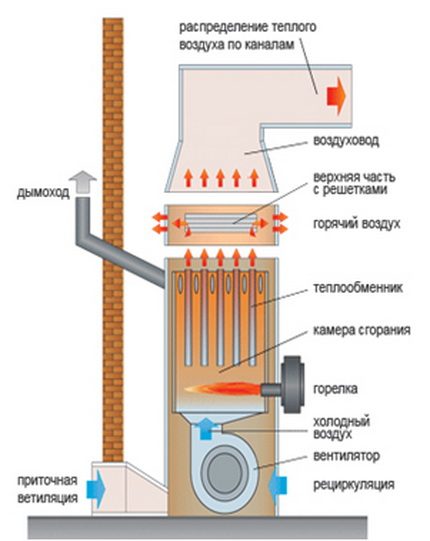
Of the shortcomings, it is worth noting possible problems with the composition of the air. The system draws polluted air masses from the street, which requires the installation of filters. They need to be changed quite often.
In addition, it is advisable to use humidifiersbecause the heated masses are often overdried. If some toxic substance, such as carbon monoxide, gets into the system, it spreads very quickly throughout the house.
Electric heating systems
To equip autonomous heating of a private house, quite often, systems powered by electricity are used. There are several types of them, consider two of the most popular.
Electric convectors are compact heaters that can be installed inside a heated room. Depending on the power of the device, it can be one or more.
The principle of operation of different types of electric convectors is similar. Cold air through the grill enters the device, where it is heated by means of an electric heater.
Due to either natural convection or the efforts of the fan, the heated air masses rise, mix with the air in the room and heat it up. The temperature in the room rises. The cooled air drops, enters the device again and the cycle repeats.
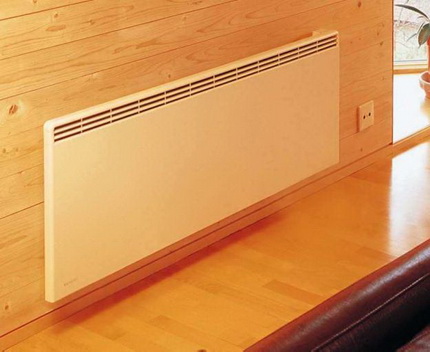
Electric heating can be realized by using infrared radiation. A thin flexible IR film is mounted on the ceiling or floor and is a kind of heating device that heats the air in the room to a comfortable temperature.
The system operates as follows. When an electric current is applied to the film, the carbon elements heat up and begin to emit infrared waves in a range safe for humans.
These waves begin to move to the first large object they encounter. It can be a floor, furniture or something like that. Items accumulate infrared waves, heat up and give off heat to the air. Heating is very fast.
At the same time, the distribution of heat is most favorable for a person: in the lower part of the room is the warmest air, in the upper - a little colder.
Doctors confirm that infrared heating similar to the sun's rays and is considered the most favorable for humans. Despite the significant difference in the principle of heating, both types of systems have similar advantages. First of all, this is the minimum cost of construction.
Not very attractive tariffs of energy retail companies do not stop those who want to get electric heating. Automation is used to control equipment, which allows you to configure the system to the most energy-efficient mode.
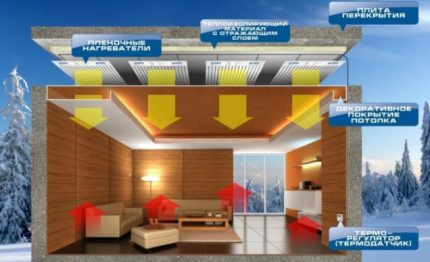
Electricity is very convenient to use. There is no need to use any fuel, which removes the problem of its storage and purchase.
In addition, solid fuel boilers, for example, are considered very “dirty” because soot and ash are formed during their operation. Electrical equipment does not have such problems. It is completely safe, does not make noise and does not produce toxic emissions.
Electrical systems are usually very compact. The devices used in them can have a very different design.Such systems are durable and require only regular maintenance.
Their main disadvantage is the costly operation, due to the high cost of electricity. Despite the cost-effectiveness of the systems, electricity bills are usually impressive.
Varieties of liquid heat transfer system
As practice shows, most often for the arrangement of autonomous heating, a system with a liquid coolant is chosen, so let's talk about its varieties. Such a system is implemented as one of two possible schemes.
The simplest scheme is a single pipe
It is an annular closed loop, inside of which heating radiators are installed in series. The coolant enters the first of them, then the next, and so on, until it returns to the boiler. This is an extremely simple scheme, however, far from the most effective.
The main disadvantage single pipe heating system consists in cooling the coolant at the “approaches” to the batteries distant from the boiler.
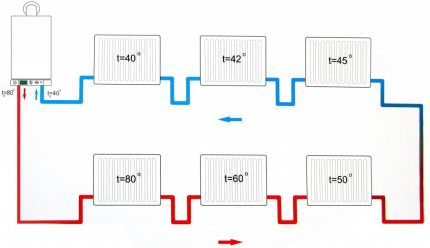
The liquid exits the boiler heat exchanger with a temperature of about 75 ° C. It arrives the same in the first radiator, in the second it is a little colder and then on. If the duration of the pipeline is small and there are few radiators, then this is not scary.
But if there are a lot of batteries, the latter will contain a coolant heated to 45-50 ° С. What is absolutely not enough for normal room heating
There can be two ways to remedy the situation. The first is to increase the temperature of the coolant or add the sections to the last radiators in the chain to increase their heat transfer. Both options will require additional cash investments, but they do not guarantee a result.
Another way to deal with the problem is to install a circulation pump. This will really increase the efficiency of a single pipe system, but also make it volatile and more expensive to operate.
Advanced Scheme - Two-Pipe
The main difference from the first scheme is that the coolant to each of the radiators is delivered almost simultaneously. A supply pipe is used to deliver it to the device, a pipe called a return pipe is used to collect and discharge it.
The coolant to the batteries can be supplied by the collector or tee scheme. In the first case, each of the devices has its own feed with a return. Pipes are laid from the collector in the form of "rays", hence the second name is "radiation".
In the tee version, the devices are connected in series to the supply and return using, the assembly is done using connectors with three nozzles - tees.
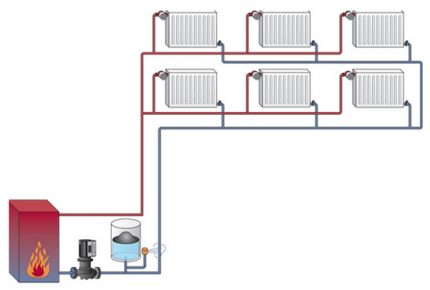
The collector involves the installation of valves on each outlet to the battery, which makes it possible to disconnect it if necessary. Job beam heating circuit It is based on forced circulation of the liquid, because there are too many hydraulic obstacles in the numerous rings for the natural movement of the coolant.
Tee varieties can work both due to natural gravity, and due to the inclusion of a circulation pump in the system. It pumps the coolant, therefore, when arranging the heating rings, it is not necessary to observe the slope, and install the supply pipe below the heating devices.
Main advantage double pipe circuit - ensuring uniform heating of all batteries in the building, no matter how many there are. But at the same time, much more pipes and other elements will be required for its installation, respectively, it will cost more. This is the main disadvantage of the two-pipe system.
Gravity Type Circulation System
The coolant inside the heating circuit must move. This can occur through natural circulation. It arises due to the difference in densities existing in a cold and heated coolant.
The heated liquid has a lower density, so it begins to spontaneously rise from the boiler along the riser, from where it is sent to the discharge pipelines and further to the radiators. The density of the cooling coolant increases, which makes it heavier.
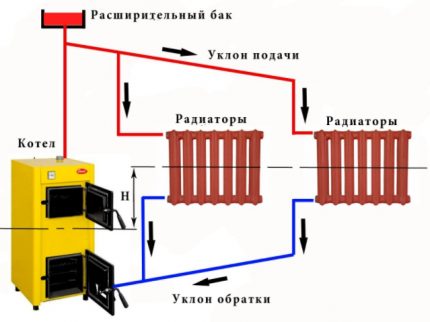
For this reason, it drops below, is collected in the reverse wiring pipeline, through which it enters the boiler. Thus, while the unit is operating, gravity-type coolant circulation will be implemented. However, its speed is relatively small and can vary.
Most of all, it depends on two factors:
- Locations of system elements. Radiators should be located much higher than the boiler or raised to the ceiling, and even better in the attic, the main riser, from which the battery taps will go.
- Temperature differences of chilled and heated coolant. The larger it is, the higher the fluid velocity. For this reason, in order to avoid heat loss, the main riser can be insulated with a special material, and the reject, on the contrary, is not closed by anything.
Among the advantages of the scheme of the heating system of a private house with natural circulation can be attributed to its cheapness and simplicity in the design, arrangement and maintenance. When working, it is absolutely silent, there is no vibration.
Disadvantages in circuits with natural circulation quite a bit of. It slowly starts up, due to the low speed of the coolant at a small temperature difference.
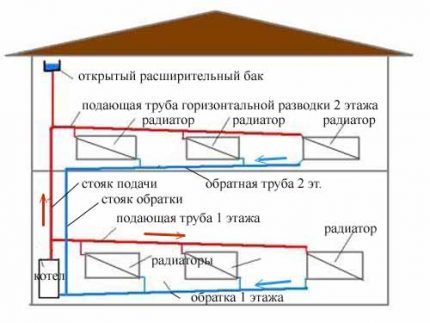
In addition, for the normal circulation of fluid in the circuit requires a pipe assembled from pipes of a relatively large diameter. Such systems are limited in size due to the low natural pressure in the line. The length of such a structure cannot exceed 30 m horizontally.
Forced Circuit
The system is included circulation pump, it induces the coolant to move at a certain speed. The pump is installed anywhere in the heating line.
But to install the pump on delivery, you only need to buy a pump from trusted manufacturers, because it will have to work in adverse conditions, although all the circulation models currently manufactured are designed for such operation.
The pump power is selected depending on the length of the pipeline and can be different. Due to forced circulation, the circuit can have different lengths, up to a very long one. The speed of advancement of the heat-transfer fluid does not depend on the temperature difference, which makes it possible to implement a variety of engineering schemes.
In addition, it becomes possible to use pipes of small diameter, this favorably affects the appearance of such a heating system.
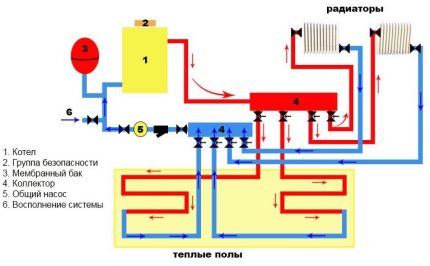
Of the disadvantages heating with pump circulation It is worth noting the volatility. This means that if there is no power supply, the heating will not work. For places where blackouts are common, this is a very serious drawback.
In addition, the installation of the pump will require additional costs for its purchase, installation and subsequent operation.
The main elements of the heating system
The set of elements included in the heating system with a liquid coolant can be very different. It all depends on the type of circuit selected. Nevertheless, several basic elements are always present. First of all, this is a boiler. The unit generates heat, it is transferred to the heat transfer fluid.
By the type of fuel used, all boilers are divided into:
- Solid fuel. All types of solid fuel are used for work: firewood, coal, peat, etc. On sale you can find varieties of such devices pellet and pyrolysis devices.
- Gas. They work on natural gas or liquefied gas.
- Electric. Generate heat by converting electricity.
- Liquid fuel. The fuel used is diesel fuel, gasoline and similar materials.
- Combined. The devices are equipped with several different burners and can work with several types of fuel.
The most practical are considered combined boilers. They help not to be left without heating in conditions with interruptions in the supply of the main type of fuel. However, the cost of such models is much higher than that of standard ones.
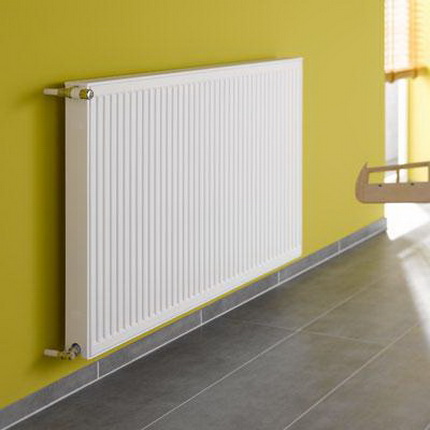
Another obligatory element of the heating system is heat storage devices. They can also be different.
The following types of radiators are distinguished:
- Panelrepresenting a one-piece steel panel of various sizes.
- Lamellarconsisting of several plates, the thickness of which can vary significantly.
- Tubular. They are made in the form of lower and upper collectors connected by pipe segments.
- Sectional. Collected from heating sections, the number of which can be any.
And the last mandatory element of this type of heating system is the pipeline.
For its assembly, metal or plastic pipes are used. The former are very durable, but subject to corrosion and difficult to install. The second ones are very simple to assemble, they do not rust, but the strength of different grades of plastics can vary significantly. Therefore, it is very important not to make a mistake in choosing a material for a plastic pipeline.
Conclusions and useful video on the topic
What method of heating a private house is more profitable:
All about the one-pipe heating scheme:
The principle of operation of air heating:
Autonomous heating can be equipped in a variety of ways. The choice of a solution will undoubtedly be affected by the climatic features of the area where the house is located.
It is hardly advisable to equip an expensive system with a liquid coolant where the winter lasts one to two months, and the temperature rarely drops below zero. It is also important to consider the features of the building and financial capabilities. If the right decision is made, the house will always be warm.
Have something to supplement, or have questions about the organization of autonomous heating of a private house? Please leave comments on the publication. The contact form is located in the lower block.

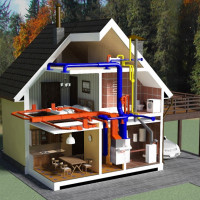 Cottage heating: schemes and nuances of organizing an autonomous heating system
Cottage heating: schemes and nuances of organizing an autonomous heating system 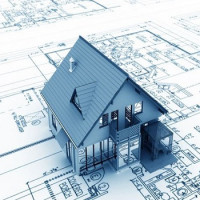 Typical schemes and rules for designing a heating system for a one-story private house
Typical schemes and rules for designing a heating system for a one-story private house 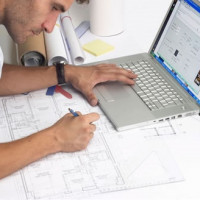 Calculation of the heating system of a private house: rules and examples of calculation
Calculation of the heating system of a private house: rules and examples of calculation 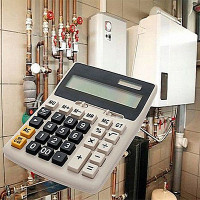 Which is cheaper: gas or electricity? Arguments for choosing a practical option for a private house
Which is cheaper: gas or electricity? Arguments for choosing a practical option for a private house 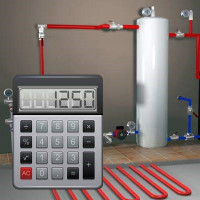 The average gas consumption for heating a house is 150 m²: an example of calculations and an overview of heat engineering formulas
The average gas consumption for heating a house is 150 m²: an example of calculations and an overview of heat engineering formulas 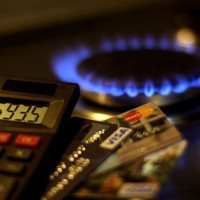 How to calculate gas consumption for heating a house in accordance with the norms
How to calculate gas consumption for heating a house in accordance with the norms  How much does it cost to connect gas to a private house: the price of organizing gas supply
How much does it cost to connect gas to a private house: the price of organizing gas supply  The best washing machines with dryer: model rating and customer tips
The best washing machines with dryer: model rating and customer tips  What is the color temperature of light and the nuances of choosing the temperature of the lamps to suit your needs
What is the color temperature of light and the nuances of choosing the temperature of the lamps to suit your needs  Replacement of a geyser in an apartment: replacement paperwork + basic norms and requirements
Replacement of a geyser in an apartment: replacement paperwork + basic norms and requirements
Private houses, too, are different. For example, we have a small one-story house, or rather, once it was an ordinary bathhouse. In winter, we save ourselves with a fan heater or an electric convector; there is also an option for stove heating in the house, but we have not used it for a long time. In the bathroom, the installation of a heated floor under the tile is nearing completion. Expensive, of course, comes out, but not more expensive than central heating.
Parents also have a small house with installed stove heating. It is unreasonable to use fan heaters and electric heaters; paying for electricity is too expensive. We think about what kind of heating is best for a small house. Because the old, stove, does not heat the entire room. I want to plan everything correctly and not financially burn out.
Hello Svetlana. Unfortunately, it is difficult to help you without knowing the details. In general, if the option of gas supply is not considered, it is easiest to install a solid fuel boiler with a water coolant.
The article is written clearly, thanks to the author. I plan to design a heating system for a log cabin wooden 2-storey building. Soon they will conduct gas to the house, especially for gas, made an extension where the gas boiler and piping will be located. The boiler is floor-standing (non-volatile), because often there are small (2-6 hours) power outages. I plan to install an emergency 12 volt pump in the system (if the power is cut off). I don’t know what the system will look like, still in thought and creative search over the project.